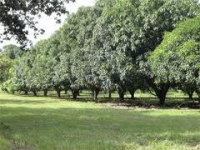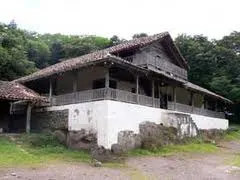Mangos (or tropical peaches) are among the most widely produced and consumed fruits around the world. Introduced to Costa Rica in 1796, limited exportation started in 1980, but this fruit still remains primarily grown for national consumption. Production estimates put mangoes between 40 and 50% of all the fruit in the world produced for juice, canning and fresh consumption. Originally cultivated on the Indian subcontinent, mangos are now produced along the equatorial band around the world, with Mexico currently holding the title as the largest exporter of fruit and Costa Rica boasting of a robust crop that is mostly enjoyed nationally.
The mango tree itself is a truly a remarkable work of Mother Nature, with cultivated specimens living for 300 years or more, and
reaching heights of 120 feet, with tap roots that can push 20 feet into the earth. The fruit is also a wonder of tropical evolution with a large seed in the center, a thick protective exterior skin and a
juicy and wonderfully peach like flavor and texture. Fruits with a more fibrous flesh often develop this less desirable texture when grown with hard water and/or chemical fertilizers.
To be permitted into the USA, fruit must undergo a process called Hot Water Quarantine Treatment to kill any fruit fly larva or mature insects. This is a process where the fruit is submerged in 115°F water for 55 to 100 minutes. This treatment process is ideal for the growing trade in organic mangos as it adds no artificial ingredients or chemicals to the post harvest process. Some countries have opted for irradiation method instead, exposing the fruit to low levels of radiation to eradicate and possibility of existing fruit flies. These fruits will not qualify for the “organic” seal of approval.
There are dozens of cultivated varieties of mangos that fall into three broad
groups in a typical USA produce department. The smallest group is the green cooking mango, which is used primarily in Southeast Asian recipes, or “Ticos” enjoy these sliced and dipped in salt…apparently an acquired taste. There is also a reddish green skinned variety which is generally quite large, as well as bright yellow skinned smaller fruits, the latter two which will start green but change coloring when the fruit is ripe and ready to eat. One popular variety is known as the Hayden. This reddish green skinned variety is plain in appearance externally but extremely flavorfully and less stringy and fibrous than most other varieties, so it is a top international seller.
variety is common throughout Costa Rica, and has a smooth melon-like texture and is widely regarded as the sweetest of all mangos. Harvested green, the Francique turns full yellow as it ripens, and provides an outstanding aroma and flavor. Mangoes are a key element of sustainable agriculture, providing soil retention on land and/or hillsides that are vulnerable to erosion, especially in challenging terrains like those found in Haiti.
areas, while the green varieties will retain some green, with a purplish coloring indicating it’s level of ripeness. For those that prefer a slightly tart Mango, the color does not need to be uniform from the stem to the flower end of the fruit, even the green coloring can provide a wonderful sweet surprise! The red blush on some varieties is due to direct exposure to sunlight and may not be a factor in the quality or ripeness of the fruit, so one has to learn which varieties suit them best and not just depend on color to pick the best mango. An important sense to engage when picking the perfect mango is the sense of smell. A ripe mango has a full, sweet fragrance easily indicating its readiness for consumption. Keep in mind that most tropical fruits, mangos included, can discolor and lose much of its flavor if refrigerated, so it is recommended to keep them at room temperature.
peel. The cubed method is the easiest for quick and clean preparation. Slice the mango along the flat part of each side of the large elongated center seed. You will end up with the flat seed center and two shallow cup-shaped pieces from each side holding the bulk of the delicious flesh. With a sharp knife, cut criss cross lines in the flesh of the mango, being careful to cut all the way to the skin, but not through it. You then invert the skin inside out, and the flesh will pop up in cubes making them easy to cut off of the skin or eat right from the skin by scraping with your teeth.
and fast growing and the canopy can be broad and rounded, even providing good overhead coverage in tropical zones inclined to sudden rainstorms. They are considered a rather large tree, often some 65 ft. across their canopy. The tree is long-lived with some specimens known to be over 300 years old and still fruiting. In deep soil the taproot descends to a depth of 20 ft, and the profuse, wide-spreading feeder roots also send down many anchor roots which penetrate for several feet and make this specimen very sturdy in otherwise normally unstable terrain.
flowers in each inflorescence are perfect, so most do not produce pollen and are not able to produce fruit. Do not worry, these trees still produce an abundance of eatable fruit over a prolonged period of time. Be warned though, these flowers often cause allergic and respiratory problems for sensitive persons, so this should always be taken into consideration if planning on growing your own mango tree (or when living near them).
Mango peel and sap contain urushiol, the chemical in poison ivy and poison sumac that can cause urushiol-induced contact dermatitis in susceptible people. Cross-reactions between mango contact allergens and urushiol have been observed. Those with a history of poison ivy or poison oak contact dermatitis may be most at risk for such an allergic reaction. Urushiol is also present in mango leaves and stems. During mango’s primary ripening season, it is the most common source of plant dermatitis.
seeds normally germinate in two to four weeks, and will bloom and bear in only three to six years. Mango fruit matures in 100 to 150 days after flowering. The fruit will have the best flavor if allowed to ripen on the tree. Otherwise, the fruit ripens best if placed stem end down in trays at room temperature and covered with a dampened cloth to avoid shriveling. Mangos generally ripen in June from a January bloom, and October to November from an April bloom. The main nutrients in mangos are
Calcium, Copper, Fiber, Iron, Magnesium, Vitamin A, B6 and C. The fruit can either be eaten by itself or paired with light meats like pork, chicken or shrimp, or added into desserts. Mango is also a nice addition to fruit salads, juices and smoothies. Pureed mango tastes delicious in muffins and cookies and is popular as baby food as well. The mango is also famous for processing into chutney, so you can see that it has many many wonderful uses!
So the next time you find yourself wandering your local supermarket aisle, visiting your local farmers market, or even better, walking around Costa Rica at the right time of year……grab that mango and enjoy the world’s most popular fruit! Happy eating, and remember that beauty can be more than skin deep!!
Simple Mango Sorbet
2 fresh, ripe mangos
1 cup sugar
3 tbsp coconut milk
1 tsp lemon juice
About 1 cup whipping cream
Peel and deflesh the mangoes , chop roughly. Blend mango with sugar until well pureed. Add coconut milk and lemon juice. Remove from blender. Pour whipping cream into blender and whirl until the cream forms stiff peaks. Add the mango puree and whirl for 10-20 seconds. Pour into container and freeze for 8 hours, stirring every 1/2 hour for the first 3 hours to prevent uneven freezing.
Author:
Kimberly Barron, originally from Malibu, California has lived in Parismina and Manuel Antonio, Costa Rica for 20 years. Starting as a certified tour guide, she spent 15 years managing fishing lodges on the Caribbean Coast and later 4* & 5* Hotels on the Pacific Coast of Costa Rica. Currently semi-retired, Kimberly still works as the Marketing Director for Byblos Resort & Casino and owns and operates her own luxury Vacation Rental Home business Manuel Antonio Rental Homes.
















































































